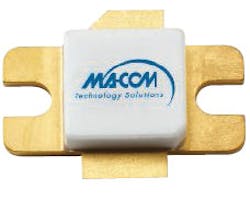Transistors based on gallium nitride (GaN), even when fabricated on silicon-carbide substrates, can pose challenges to proper thermal management. These devices deliver high RF power densities and can lead to hot spots on printed-circuit boards (PCBs) when thermal paths are not thoughtfully designed. Fortunately, the latest line of discrete GaN-on-SiC power transistors from M/A-COM Technology Solutions is accompanied by versions of those same transistors mounted on compact circuit boards as pallet amplifiers, complete with input and output matching circuitry. The new devices and pallet amplifiers are fabricated in a 0.5- m GaN high-electron-mobility-transistor (HEMT) process and target s-band radar, avionics, electronic-warfare (EW), and general-purpose applications, supporting pulsed applications through 3.5 GHz at peak power levels to 180 W.
Discrete GaN transistors such as the model MAGX-003135-180L00 are supplied in rugged flange-mount packages fabricated from copper and molybdenum (Fig. 1). The transistor delivers 180 W peak output power from 3.1 to 3.5 GHz (18 W average power). When characterized with 300-s pulses at 10% duty cycle, the depletion-mode transistor yields 11.4-dB typical gain at the peak rated output power, with 41% typical drain efficiency. The test conditions for those measurements include quiescent drain current of 250 ma and drain voltage of 60 V.
Model MAGX-003135-180L00 features a common-source configuration and is designed for broadband Class AB operation. It is rated for maximum drain-to-source voltage of 175 V. The typical return loss is 16 db at 3.1 GHz, 12 dB at 3.3 GHz, and 18 db at 3.5 GHz, measured at a drain voltage of 60 V. The RoHs-compliant device exhibits load mismatch stability into a 5.0:1 VSWR mismatch with 14 W peak (pulsed) input power and 1.4 W average continuous-wave (CW) input power, with tolerance of load mismatches as severe as a 10.0:1 VSWR under those same input-signal conditions.
For those who prefer the convenience of having this level of performance in a prematched 50-Ω input/output drop-in amplifier format, pallet versions are available. Model MAPG-003135-180L00 (Fig. 2) operates over the frequency range from 3.1 to 3.5 GHz with 180 peak output power. It provides 12 dB gain at that output-power level when fed with 500-s pulses at a 10% duty cycle.
Additional transistors in the Gan-on-SiC line include the unmatched models MAGX-000035-030000, which is capable of operation between 1 MHz and 3.5 GHz, and model MaGX-000035-100000, which is designed for use from 2.7 to 3.1 GHz. Both can be used for pulsed or CW applications. The MAGX-000035-030000 delivers 42 W CW output power with 20 db gain and 59% efficiency at 1.5 GHz; and 40 W CW output power with 14 dB gain and 56% efficiency at 3 GHz. the MaGX-002731-180L00 GaN transistor is ideal for high-power pulsed radar applications. It generates 180 W peak output power under pulsed conditions (300-s pulse at 10% duty cycle) from 2.7 to 3.1 GHz. The rugged transistor can also provide 18 W CW output power across that same frequency range when applications over that frequency range require lower but continuous average output-power levels. The drain efficiency is typically 50% with typical power gain of 11.5 dB. The pallet amplifier version of the MAGX-002731-180L00 is the model MAPG-002731-180L00, also with 180 W peak output power and 18 W CW output power (with 11.5-dB power gain) from 2.7 to 3.1 GHz.
About the Author
Jack Browne
Technical Contributor
Jack Browne, Technical Contributor, has worked in technical publishing for over 30 years. He managed the content and production of three technical journals while at the American Institute of Physics, including Medical Physics and the Journal of Vacuum Science & Technology. He has been a Publisher and Editor for Penton Media, started the firm’s Wireless Symposium & Exhibition trade show in 1993, and currently serves as Technical Contributor for that company's Microwaves & RF magazine. Browne, who holds a BS in Mathematics from City College of New York and BA degrees in English and Philosophy from Fordham University, is a member of the IEEE.
